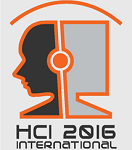Toronto, Canada, 17 - 22 July 2016
The Westin Harbour Castle Hotel
Tuesday, 19 July 2016, 09:00 - 12:30
> Aaron Marcus (short bio)
Aaron Marcus and Associates (AM+A), Berkeley, California, United States
Objectives:
Participants in this course will:
- Understand how mobile devices and their applications have/have not incorporated fundamental principles of user-centered design to achieve usability, usefulness, and appeal
- Understand current development challenges and issues
- Understand how to use their professional knowledge to look at current developments.
Participants should be generally familiar with user-interface development steps (planning, research, analysis, design, evaluation, implementation, documentation, training) and user-interface components (metaphors, mental models, navigation, interaction, and experience), but may have little or no experience in with current mobile applications development worldwide.
Participants can use their knowledge of user-experience design, interaction design, visual design, software/hardware engineering, ethnography, anthropology, and usability analysis to find new insights in this course in new ways to apply their expertise and experience.
Concepts covered to assist professionals to design more effectively are these:
- User Analysis: Specification of user demographics and user-environment, user modeling, task analysis, and accounting for business objectives
- Metaphors: Easy recognized and remembered, fundamental concepts conveyed through words, signs, and images
- Mental models: Appropriate organization of data, functions, tasks, roles and people
- Navigation of mental model: Efficient movement within the mental model via windows, menus, dialogue boxes, or control panels
- Interaction: Effective input and output-feedback sequencing
- Appearance: Quality visual, acoustic, and touch characteristics
- Information Visualization: Tables, charts, maps, and diagrams
- Basic visual design: Scale, proportion, rhythm, symmetry, and balance
- Cross-cultural communication
- User-centered design process
Content and Benefits:
This tutorial presents essential concepts of mobile user-experience design and reviews mobile UX trends in the US, Europe, and Asia. The lectures also provide detailed case studies of developing UX designs: general trends for China; a classic disaster of mobile UX design for a police telecom system due to lack of user-centered design; and other key issues of mobile UX design for smart phones tablets, and wearables, Participants in this tutorial will learn new terms, concepts, and issues to understand mobile user-centered design, guidelines, personas, and use-scenarios; learn latest trends and challenges of design of mobile user-experience (UX) and human-computer interface (HCI) components (metaphors, mental models, navigation, interaction, and appearance); and learn practical trade-offs from studying competitive analyses and case-study results.
Detailed Description and Allocation of Time
Lecture 0: Introduction to instructor and tutorial (15 minutes)
Introduces the schedule, objectives, and speaker’s credentials.
Lectures 1: Introduction to the topic and specific subject topics: (about 180 minutes)
This lecture introduces key terminology and concepts regarding mobile user-experience design and the topics listed.
- Mobile UI Design Intro, Tour and Book Summary
- Asian Technology Trends and Culture Issues
- Culture-Centered Case Study Wukong Project
- Case Study: San Jose Police Department
- New Mobile UI/UX Trends
- Mobile Persuasion Design
- Emerging UX Design Trends in China
Discussion: Q+A (15 minutes)
Bio Sketch of Presenter:

Mr. Marcus has been researching and designing mobile user-experience design since 1989. He received a BA in Physics from Princeton University (1965) and a BFA and MFA in Graphic Design from Yale University Art School (1968). He is an internationally recognized authority on the design of user interfaces, interactive multimedia, and printing/publishing documents. Mr. Marcus has given tutorials at HCII, SIGGRAPH, SIGCHI, HFES, UXPA and other conferences, and at seminars for businesses and academic institutions around the world. He published 23 books and more than 300 articles, including Human Factors and Typography for More Readable Programs (1990), The Cross-GUI Handbook (1994), Mobile TV: Customizing Content and Context (2010), Graphic Design for Electronic Documents and User Interfaces (1992), The Past 100 Years of the Future: UX in Sci-Fi Movies and Television (2012), Mobile Persuasion Design (2015), and HCI/User-Experience Design: Fast Forward to the Past, Present, and Future (2015). Mr. Marcus was the world’s first professional graphic designer to be involved full-time in computer graphics (1967), to program a desktop publishing system (for the AT&T Picturephone, 1969-71), to design virtual realities (1971-73), and to establish an independent computer-based user-interface and information-visualization firm (1982). In 1992, he received the National Computer Graphics Association Industry Achievement Award for contributions to computer graphics. In 2008, the AIGA named him a Fellow; in 2009, CHI elected him to the CHI Academy. He is a Visiting Professor, Institute of Design, IIT, Chicago, and College of Design and Innovation, Tongji University, Shanghai.
Mr. Marcus is Principal of Aaron Marcus and Associates, a user-interface and information-visualization development firm with more than 34 years of experience in helping people make smarter decisions faster, at work, at home, at play, and on the way. AM+A), has developed user-centered, task-oriented solutions for complex computer-based design and communication challenges for clients worldwide on all major platforms (client-server networks, the Web, mobile devices, appliances, and vehicles), for most vertical markets, and for most user communities within companies and among their customers. AM+A has served corporate, government, education, and consumer-oriented clients to meet their needs for usable products and services with proven improvements in readability, comprehension, and appeal. AM+A uses its well-established methodology to help them plan, research, analyze, design, implement, evaluate, train, and document metaphors, mental models, navigation, interaction and appearance. AM+A has developed ten concept designs for mobile persuasion design, documented in Mobile Persuasion Design (2015). AM+A’s mobile-oriented clients include BMW, DaimlerChrysler, HP, Microsoft, Motorola, Nokia, Sabre, Samsung, SAP, and Siemens.



